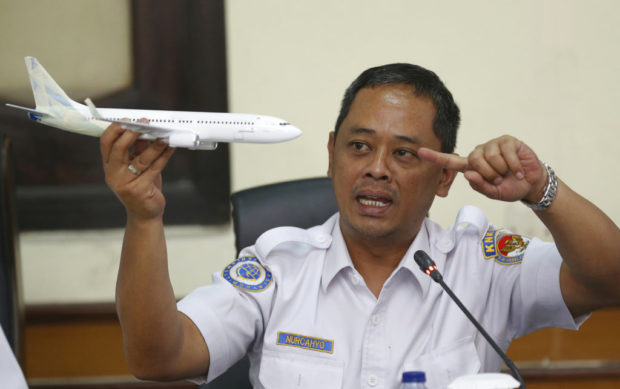Report faults Indonesian airline’s safety measures in crash

National Transportation Safety Committee investigator Nurcahyo Utomo holds a model of an airplane during a press conference on the committee’s preliminary findings on their investigation on the crash of Lion Air flight 610, in Jakarta, Indonesia on Nov. 28, 2018.
JAKARTA, Indonesia — A report based on black box data from an Indonesian Lion Air jet that crashed last month cites equipment failures and the airline’s safety measures as factors in the disaster.
The data reported Wednesday showed the pilots of the Boeing 737 MAX 8 struggled to maintain control as an automatic safety system repeatedly forced the plane’s nose down. The report repeats recommendations that pilots be better versed in emergency procedures aware of past aircraft problems.
The probe into the crash has mainly focused on whether faulty information from sensors caused the accident. The new 737 MAX 8 plunged into the Java Sea on Oct. 29, killing all 189 people on board.
Shortly after the catastrophe, the airline issued a notice to pilots urging them to be more proactive in reporting problems.
Nurcahyo Utomo, an investigator for Indonesia’s National Transportation Safety Commission, told reporters in Jakarta on Wednesday that four of the crashed aircraft’s previous flights had experienced technical problems, with two showing no such difficulties.
Article continues after this advertisementHe said investigators were trying to understand what maintenance workers had done to try to fix the problems and if there were other steps that should have been taken.
Article continues after this advertisement“Even if the pilot did not have time to meet with the engineer, he should be able to know what the problems experienced by the aircraft before,” Utomo said.
In a statement, Boeing played up the possibility of pilot error.
“As our customers and their passengers continue to fly the 737 MAX to hundreds of destinations around the world every day, they have our assurance that the 737 MAX is as safe as any airplane that has ever flown the skies,” it said in a statement.
The aircraft manufacturer noted that the report on the details of the doomed flight cited actions by the flight crew that led to the crash and that the airline’s maintenance work and procedures had failed to fix the aircraft’s repeated problems.
The MAX aircraft is the latest version of Boeing’s popular 737 jetliner. It is equipped with an automated system that pushes the nose down if a sensor detects that the nose is pointed so high that the plane could go into an aerodynamic stall. Records on the replacement of a key component, an angle-of-attack, or AOA sensor, shortly before the aircraft’s final flight were incomplete, the report said.
It noted that erroneous AOA data distorted measurements of the plane’s speed and altitude, contributing to the crash.
Peter Lemme, an expert in aviation and satellite communications and a former Boeing engineer who wrote an analysis of the data on his blog, likened the problems to “a deadly game of tag” in which the plane pointed down, the pilots countered by manually aiming the nose higher, only for the sequence to repeat about five seconds later.
That happened 26 times during the 11-minute flight, but pilots failed to recognize what was happening and follow the known procedure for countering incorrect activation of the automated safety system, Lemme told The Associated Press.
Lemme said he was also troubled that there weren’t easy checks to see if sensor information was correct, that the crew of the fatal flight apparently wasn’t warned that similar problems had occurred on previous flights, and that the Lion Air jet wasn’t fully repaired after those flights.
“Had they fixed the airplane, we would not have had the accident,” he said. “Every accident is a combination of events, so there is disappointment all around here,” he said.
The Indonesian investigation is continuing with help from US regulators and Boeing. Searchers have not found the plane’s cockpit voice recorder, which would provide more information about the pilots’ actions.
More than 200 MAX jets have been delivered to airlines around the world. Pilots at American Airlines and Southwest Airlines complained this month that they had not been given all information about the new automated anti-stall safety system on the MAX. /ee